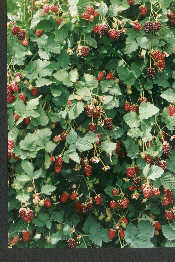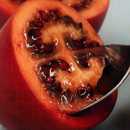Boysenberry Brulee |
Boysenberry Mapua |
| |
||
 |
||
 |
||
 |
||
In proper botanical language, it is not a berry at all, but instead an aggregate fruit of numerous drupelets around a central core. It typically grows in forest clearings or fields, particularly where fire or wood-cutting has produced open space by this opportunistic colonizer of disturbed soil. The raspberry like flower can be a major nectar source for honeybees. As a cultivated plant in moist temperature regions, it is easy to grow. This hybrid berry (also known as brambles) is a cross between a blackberry and a raspberry.
Landscape Value
Train on a trellis to support fruit. Alternatively train like a pillar-rose.
Nutritional Value
High in antioxidants and rich in Vitamin C.
How to Eat
Fresh, fresh and fresh in Gran
Growing
Sun
Full sun.
Wind
Does not tolerate wind & salty marine conditions.
Climate
Performs well in both warm and cool climates. Is frost tolerant as they become dormant.
Soil
Boysenberries prefer a slightly acidic soil and free draining. Mulch well to ensure the root systems remain moist during the growing season.
Fertiliser
An application of general fertiliser in spring with compost mulch is all that is required. Too much nitrogen will encourage leaf production instead of flowers.
Pruning
Prune in winter to remove all canes that have fruited and all damaged and weak canes. Remove canes to the base, any fully thorny canes should be cut off as low to the ground as possible. Tie up young trailing canes to a trellis system, they will fruit in the second year. Remove tips so canes do not become too long and encourage fruiting laterals.
Pests
Good hygiene and not growing plants in wet soils will keep many diseases at bay. Bird netting may be needed. A spring spray at bud burst for insectfestation and regular sprays will ensure fruit are pest free.
Hardiness
-5°C
Special Conditions
Cold weather at flowering will result in poor pollination and therefore small fruit.


